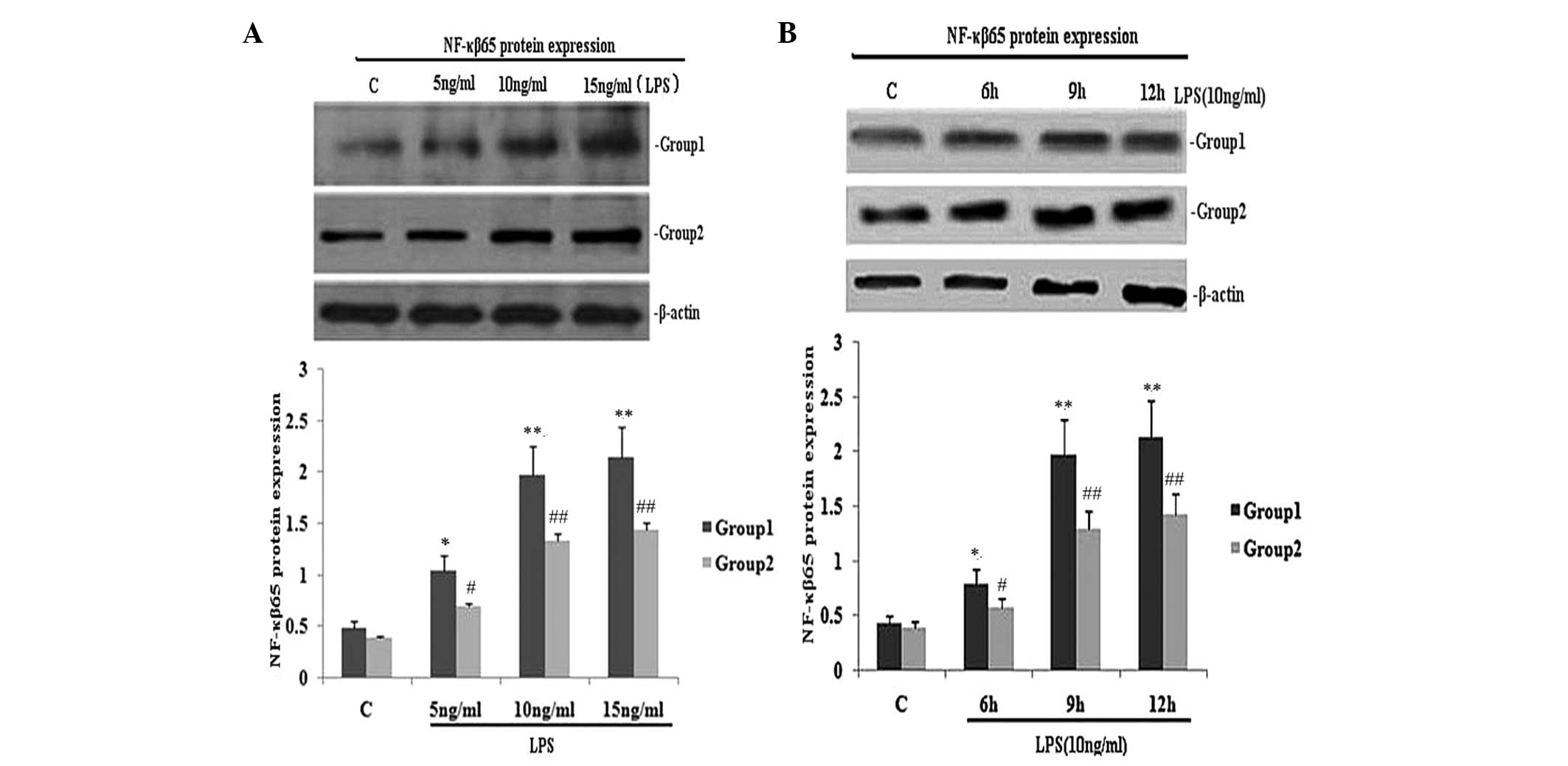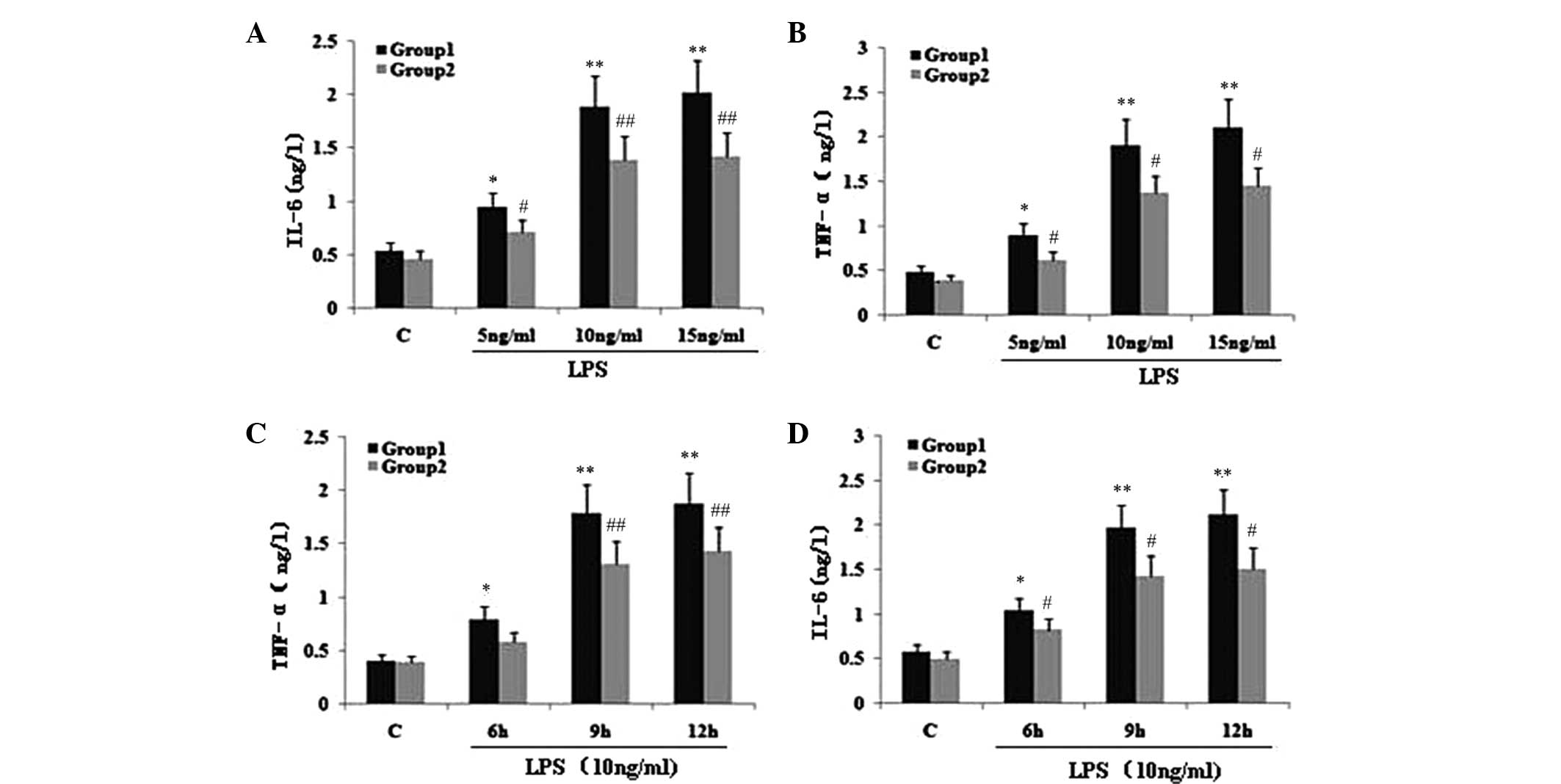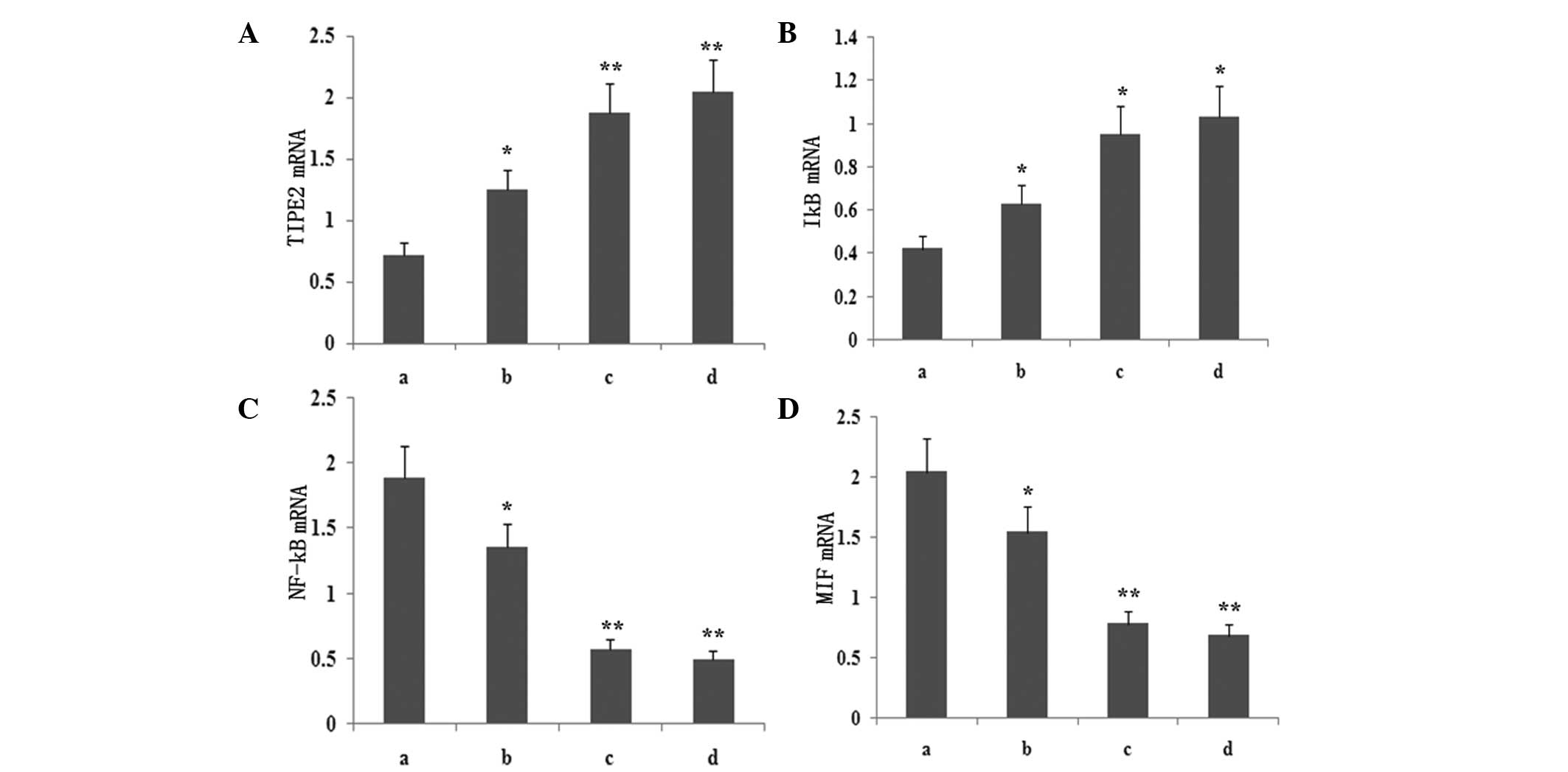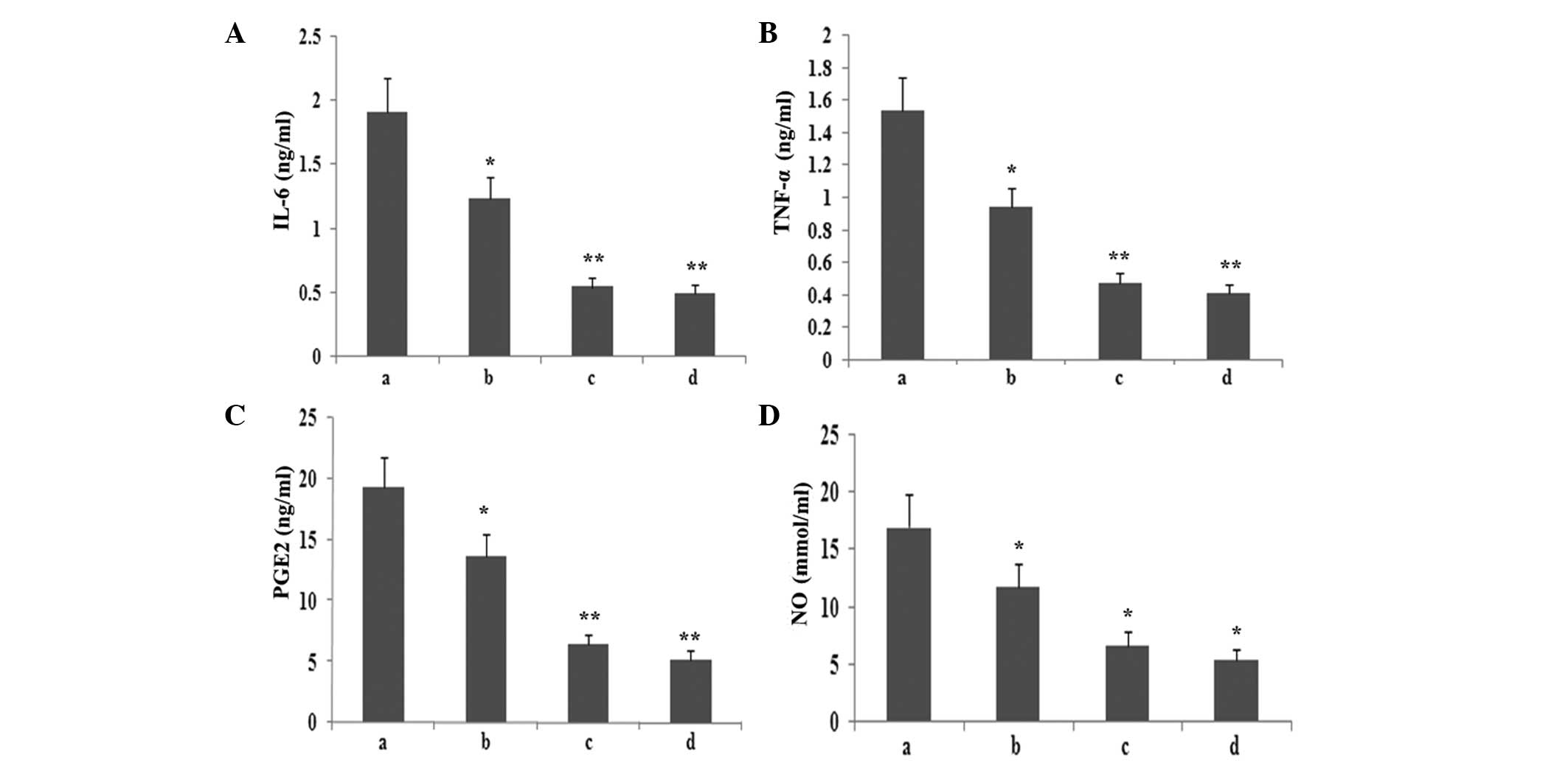|
1
|
Wynn J, Cornell TT, Wong HR, Shanley TP
and Wheeler DS: The host response to sepsis and developmental
impact. Pediatrics. 125:1031–1041. 2010. View Article : Google Scholar : PubMed/NCBI
|
|
2
|
Unuma K, Aki T, Funakoshi T, Yoshida K and
Uemura K: Cobalt protoporphyrin accelerates TFEB activation and
lysosome reformation during LPS-induced septic insults in the rat
heart. PLoS One. 8:e565262013. View Article : Google Scholar : PubMed/NCBI
|
|
3
|
Juskewitch JE, Prasad S, Salas CF and
Huskins WC: Reliability of the identification of the systemic
inflammatory response syndrome in critically ill infants and
children. Pediatr Crit Care Med. 13:e55–e57. 2012. View Article : Google Scholar : PubMed/NCBI
|
|
4
|
Walley KR, Lukacs NW, Standiford TJ,
Strieter RM and Kunkel SL: Balance of inflammatory cytokines
related to severity and mortality of murine sepsis. Infect Immun.
64:4733–4738. 1996.PubMed/NCBI
|
|
5
|
Cinel I and Opal SM: Molecular biology of
inflammation and sepsis: a primer. Crit Care Med. 37:291–304. 2009.
View Article : Google Scholar : PubMed/NCBI
|
|
6
|
Woodward MJ, de Boer J, Heidorn S, Hubank
M, Kioussis D, Williams O and Brady HJ: TNFAIP8 is an essential
gene for the regulation of glucocorticoid-mediated apoptosis of
thymocytes. Cell Death Differ. 17:316–323. 2010. View Article : Google Scholar : PubMed/NCBI
|
|
7
|
Wang Z, Fayngerts S, Wang P, et al: TIPE2
protein serves as a negative regulator of phagocytosis and
oxidative burst during infection. Proc Natl Acad Sci USA.
109:15413–15418. 2012. View Article : Google Scholar : PubMed/NCBI
|
|
8
|
Freundt EC, Bidere N and Lenardo MJ: A
different TIPE of immune homeostasis. Cell. 133:401–402. 2008.
View Article : Google Scholar : PubMed/NCBI
|
|
9
|
Antonopoulos AS, Margaritis M, Lee R,
Channon K and Antoniades C: Statins as anti-inflammatory agents in
atherogenesis: molecular mechanisms and lessons from the recent
clinical trials. Curr Pharm Des. 18:1519–1530. 2012. View Article : Google Scholar : PubMed/NCBI
|
|
10
|
Truwit JD: Statins: a role in infected
critically ill patients? Crit Care. 15:1452011. View Article : Google Scholar : PubMed/NCBI
|
|
11
|
Rubinson DA, Dillon CP, Kwiatkowski AV, et
al: A lentivirus-based system to functionally silence genes in
primary mammalian cells, stem cells and transgenic mice by RNA
interference. Nat Genet. 33:401–406. 2003. View Article : Google Scholar : PubMed/NCBI
|
|
12
|
Wu L, Gokden N and Mayeux PR: Evidence for
the role of reactive nitrogen species in polymicrobial
sepsis-induced renal peritubular capillary dysfunction and tubular
injury. J Am Soc Nephrol. 18:1807–1815. 2007. View Article : Google Scholar : PubMed/NCBI
|
|
13
|
Dombrovskiy VY, Martin AA, Sunderram J and
Paz HL: Rapid increase in hospitalization and mortality rates for
severe sepsis in the United States: a trend analysis from 1993 to
2003. Crit Care Med. 35:1244–1250. 2007. View Article : Google Scholar : PubMed/NCBI
|
|
14
|
Vigil KJ, Adachi JA and Chemaly RF: Viral
pneumonias in immunocompromised adult hosts. J Intensive Care Med.
25:307–326. 2010. View Article : Google Scholar : PubMed/NCBI
|
|
15
|
Hlava N, Niemann CU, Gropper MA and
Melcher ML: Postoperative infectious complications of abdominal
solid organ transplantation. J Intensive Care Med. 24:3–17. 2009.
View Article : Google Scholar : PubMed/NCBI
|
|
16
|
Zhao J, Yang X, Auh SL, Kim KD, Tang H and
Fu YX: Do adaptive immune cells suppress or activate innate
immunity? Trends Immunol. 30:8–12. 2009. View Article : Google Scholar : PubMed/NCBI
|
|
17
|
Kim KD, Zhao J, Auh S, Yang X, Du P, Tang
H and Fu YX: Adaptive immune cells temper initial innate responses.
Nat Med. 13:1248–1252. 2007. View
Article : Google Scholar : PubMed/NCBI
|
|
18
|
López-Rincón G, Pereira-Suárez AL, Del
Toro-Arreola S, et al: Lipopolysaccharide induces the expression of
an autocrine prolactin loop enhancing inflammatory response in
monocytes. J Inflamm (Lond). 10:242013.PubMed/NCBI
|
|
19
|
Jeong IK, Oh da H, Park SJ, et al:
Inhibition of NF-κB prevents high glucose-induced proliferation and
plasminogen activator inhibitor-1 expression in vascular smooth
muscle cells. Exp Mol Med. 43:684–692. 2011.
|
|
20
|
Lin CC, Shih CH, Yang YL, et al: Thrombin
induces inducible nitric oxide synthase expression via the MAPK,
MSK1, and NF-κB signaling pathways in alveolar macrophages. Eur J
Pharmacol. 672:180–187. 2011.PubMed/NCBI
|
|
21
|
Zhang LJ, Liu X, Gafken PR, Kioussi C and
Leid M: A chicken ovalbumin upstream promoter transcription factor
I (COUP-TFI) complex represses expression of the gene encoding
tumor necrosis factor alpha-induced protein 8 (TNFAIP8). J Biol
Chem. 284:6156–6168. 2009. View Article : Google Scholar
|
|
22
|
Sun H, Gong S, Carmody RJ, et al: TIPE2, a
novel negative regulator of innate and adaptive immunity that
maintains immune homeostasis. Cell. 133:415–426. 2008. View Article : Google Scholar : PubMed/NCBI
|
|
23
|
Laliberté B, Wilson AM, Nafisi H, et al:
TNFAIP8: a new effector for Galpha(i) coupling to reduce cell death
and induce cell transformation. J Cell Physiol. 225:865–874.
2010.PubMed/NCBI
|
|
24
|
Antosz H and Choroszyńska D: Negative
regulation of Toll-like receptor signalling. Postepy Hig Med Dosw
(Online). 67:339–350. 2013.(In Polish).
|
|
25
|
Zhang X, Wang J, Fan C, et al: Crystal
structure of TIPE2 provides insights into immune homeostasis. Nat
Struct Mol Biol. 16:89–90. 2009. View Article : Google Scholar : PubMed/NCBI
|
|
26
|
Li D, Song L, Fan Y, et al:
Down-regulation of TIPE2 mRNA expression in peripheral blood
mononuclear cells from patients with systemic lupus erythematosus.
Clin Immunol. 133:422–427. 2009. View Article : Google Scholar : PubMed/NCBI
|
|
27
|
Zhang Y, Zeng X, Chen S, et al:
Characterization, epitope identification and mechanisms of the
anti-septic capacity of monoclonal antibodies against macrophage
migration inhibitory factor. Int Immunopharmacol. 11:1333–1340.
2011. View Article : Google Scholar
|
|
28
|
Healy ZR, Liu H, Holtzclaw WD and Talalay
P: Inactivation of tautomerase activity of macrophage migration
inhibitory factor by sulforaphane: a potential biomarker for
anti-inflammatory intervention. Cancer Epidemiol Biomarkers Prev.
20:1516–1523. 2011. View Article : Google Scholar : PubMed/NCBI
|
|
29
|
Donnelly LE and Rogers DF: Novel targets
and drugs in inflammatory lung disease. Curr Opin Pharmacol.
8:219–221. 2008. View Article : Google Scholar : PubMed/NCBI
|
|
30
|
Tu YP, Chuang SJ, Chen SC, et al:
Simvastatin induces the expression of hemeoxygenase-1 against
ischemia-reperfusion injury on the testes in rats. Toxicol Lett.
207:242–250. 2011. View Article : Google Scholar : PubMed/NCBI
|
|
31
|
Park JS, Jung JS, Jeong YH, et al:
Antioxidant mechanism of isoflavone metabolites in hydrogen
peroxide-stimulated rat primary astrocytes: critical role of heme
oxygenase-1 and NQO1 expression. J Neurochem. 119:909–919. 2011.
View Article : Google Scholar : PubMed/NCBI
|
|
32
|
Nassar NN, Li G, Strat AL and Abdel-Rahman
AA: Enhanced hemeoxygenase activity in the rostral ventrolateral
medulla mediates exaggerated hemin-evoked hypotension in the
spontaneously hypertensive rat. J Pharmacol Exp Ther. 339:267–274.
2011. View Article : Google Scholar
|
|
33
|
Kagami S, Kanari H, Suto A, et al: HMG-CoA
reductase inhibitor simvastatin inhibits proinflammatory cytokine
production from murine mast cells. Int Arch Allergy Immunol.
146(Suppl 1): 61–66. 2008. View Article : Google Scholar : PubMed/NCBI
|
|
34
|
Trezzi M, Blackstone EH, Sun ZY, et al:
Statin therapy is associated with fewer infections after cardiac
operations. Ann Thorac Surg. 95:892–900. 2013. View Article : Google Scholar : PubMed/NCBI
|
|
35
|
Chello M, Anselmi A, Spadaccio C, et al:
Simvastatin increases neutrophil apoptosis and reduces inflammatory
reaction after coronary surgery. Ann Thorac Surg. 83:1374–1380.
2007. View Article : Google Scholar : PubMed/NCBI
|
|
36
|
Chello M, Mastroroberto P, Patti G,
D’Ambrosio A, Morichetti MC, Di Sciascio G and Covino E:
Simvastatin attenuates leucocyte-endothelial interactions after
coronary revascularisation with cardiopulmonary bypass. Heart.
89:538–543. 2003. View Article : Google Scholar
|
|
37
|
Chaudhry MZ, Wang JH, Blankson S and
Redmond HP: Statin (cerivastatin) protects mice against sepsis
related death via reduced proinflammatory cytokines and enhanced
bacterial clearance. Surg Infect (Larchmt). 9:183–194. 2008.
View Article : Google Scholar
|
|
38
|
Fraunberger P, Gröne E, Gröne HJ and Walli
AK: Simvastatin reduces endotoxin induced nuclear factor kappaB
activation and mortality in guinea pigs despite lowering
circulating low density lipoprotein cholesterol. Shock. 32:159–163.
2009. View Article : Google Scholar
|
|
39
|
Lin H, Xiao Y, Chen G, et al: HMG CoA
reductase inhibitor simvastatin suppresses Toll like receptor 2
ligand induced activation of nuclear factor kappa B by preventing
RhoA activation in monocytes from rheumatoid arthritis patients.
Rheumatol Int. 31:1451–1458. 2011. View Article : Google Scholar
|
|
40
|
Meijvis SC, van de Garde EM, Rijkers GT
and Bos WJ: Treatment with anti inflammatory drugs in community
acquired pneumonia. J Intern Med. 272:25–35. 2012. View Article : Google Scholar : PubMed/NCBI
|
|
41
|
Fogerty MD, Efron D, Morandi A, Guy JS,
Abumrad NN and Barbul A: Effect of preinjury statin use on
mortality and septic shock in elderly burn patients. J Trauma.
69:99–103. 2010. View Article : Google Scholar : PubMed/NCBI
|
|
42
|
González CM, Luna AH, Morales MP, Sanchez
JA, Guzman CO and Granillo GF: Statin anti-inflammatory therapy in
septic patients. Critical Care. 12(Suppl5): P26–P35. 2008.
|


















